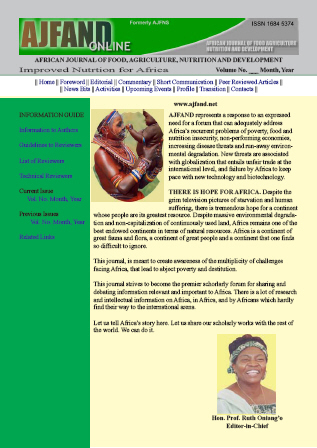
|
African Journal of Food, Agriculture, Nutrition and Development
Rural Outreach Program
ISSN: 1684-5358
EISSN: 1684-5358
Vol. 13, No. 4, 2013, pp. 1-13
|
 Bioline Code: nd13056
Bioline Code: nd13056
Full paper language: English
Document type: Short Communication
Document available free of charge
|
|
|
African Journal of Food, Agriculture, Nutrition and Development, Vol. 13, No. 4, 2013, pp. 1-13
| en |
FOOD SECURITY PROBLEMS IN VARIOUS INCOME GROUPS OF KENYA
Tom, Olielo
Abstract
Poverty and hunger are common in Kenya especially in arid and semi arid lands that cannot support crops and are also overgrazed thereby yielding low incomes, and in urban low income dwellings. Indicators of food insecurity and malnutrition such as proportion of the poor in the population, those requiring food assistance and anthropometric measurements have through the years shown that large proportions, about half the population of Kenya are food insecure. Among the affected, around 3.5 million go hungry or are malnourished. Increasing income promotes consumption of diverse foods and facilitates change in diets from basic staples such as maize to foods that require less preparation fruits and processed foods. This research was carried out to assess consumption of foods and characteristics of various income groups and determine factors that cause food insecurity. Three Nairobi housing estates were selected to represent low income group, medium income group, and high income group. These estates are, respectively, Kayole, Buruburu and Westlands. Monthly income by the low income, medium income and high income households were, respectively, KES ≤ 14000 (US$ 177.5), 14001 to 56000 (US$178 to 812) and ≥ 56000 (US$ 812). In each estate, a sample of 130 households was studied. The average household had 5 people. Ugali (thick porridge) is the main staple food and was consumed by 88% of the households, while vegetables were consumed by 92 %. Meat was consumed by 46 % of the households and fruit products by 17 %. It was found that the low income group could not purchase adequate food and amounts they consumed did not meet the FAO recommended levels for foods and nutrients. Low incomes and poverty are the main cause of food insecurity in Kenya. It is recommended that there be better education for employment, irrigation of crops especially in arid and semi arid lands for food production as well as improved health status and sanitation to enable earning of high income to reduce poverty and consequently enhance food security and nutrition.
Keywords
poverty; income; irrigation; food; security
|
| |
© African Journal of Food, Agriculture, Nutrition and Development
Alternative site location: http://www.ajfand.net/
|
|
